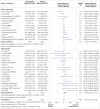Effectiveness of physical activity interventions delivered or prompted by health professionals in primary care settings: systematic review and meta-analysis of randomised controlled trials
- PMID: 35197242
- PMCID: PMC8864760
- DOI: 10.1136/bmj-2021-068465
Effectiveness of physical activity interventions delivered or prompted by health professionals in primary care settings: systematic review and meta-analysis of randomised controlled trials
Abstract
Objective: To examine the effectiveness of physical activity interventions delivered or prompted by primary care health professionals for increasing moderate to vigorous intensity physical activity (MVPA) in adult patients.
Design: Systematic review and meta-analysis of randomised controlled trials.
Data sources: Databases (Medline and Medline in progress, Embase, PsycINFO, CINAHL, SPORTDiscus, Sports Medicine and Education Index, ASSIA, PEDro, Bibliomap, Science Citation Index, Conference Proceedings Citation Index), trial registries (Cochrane Central Register of Controlled Trials, ClinicalTrials.gov, TRoPHI), and grey literature (OpenGrey) sources were searched (from inception to September 2020).
Eligibility criteria for selecting studies: Randomised controlled trials of aerobic based physical activity interventions delivered or prompted by health professionals in primary care with a usual care control group or another control group that did not involve physical activity.
Study selection and analysis: Two independent reviewers screened the search results, extracted data from eligible trials and assessed the risk of bias using the Cochrane risk of bias tool (version 2). Inverse variance meta-analyses using random effects models examined the primary outcome of difference between the groups in MVPA (min/week) from baseline to final follow-up. The odds of meeting the guidelines for MVPA at follow-up were also analysed.
Results: 14 566 unique reports were identified and 46 randomised controlled trials with a range of follow-ups (3-60 months) were included in the meta-analysis (n=16 198 participants). Physical activity interventions delivered or prompted by health professionals in primary care increased MVPA by 14 min/week (95% confidence interval 4.2 to 24.6, P=0.006). Heterogeneity was substantial (I2=91%, P<0.001). Limiting analyses to trials that used a device to measure physical activity showed no significant group difference in MVPA (mean difference 4.1 min/week, 95% confidence interval -1.7 to 9.9, P=0.17; I2=56%, P=0.008). Trials that used self-report measures showed that intervention participants achieved 24 min/week more MVPA than controls (95% confidence interval 6.3 to 41.8, P=0.008; I2=72%, P<0.001). Additionally, interventions increased the odds of patients meeting guidelines for MVPA by 33% (95% confidence interval 1.17 to 1.50, P<0.001; I2=25%, P=0.11) versus controls. 14 of 46 studies were at high risk of bias but sensitivity analyses excluding these studies did not alter the results.
Conclusions: Physical activity interventions delivered or prompted by health professionals in primary care appear effective at increasing participation in self-reported MVPA. Such interventions should be considered for routine implementation to increase levels of physical activity and improve health outcomes in the population.
Systematic review registration: PROSPERO CRD42021209484.
© Author(s) (or their employer(s)) 2019. Re-use permitted under CC BY. No commercial re-use. See rights and permissions. Published by BMJ.
Conflict of interest statement
Competing interests: All authors have completed the ICMJE uniform disclosure form at www.icmje.org/disclosure-of-interest/ and declare: AJD is supported by a National Institute for Health Research (NIHR) Research Professorship award; no financial relationships with any organisations that might have an interest in the submitted work in the previous three years; no other relationships or activities that could appear to have influenced the submitted work.
Figures



References
-
- World Health Organization. Global action plan on physical activity 2018-2030: more active people for a healthier world. Geneva, 2018 https://apps.who.int/iris/bitstream/handle/10665/272722/9789241514187-en....
Publication types
MeSH terms
LinkOut - more resources
Full Text Sources
Medical
